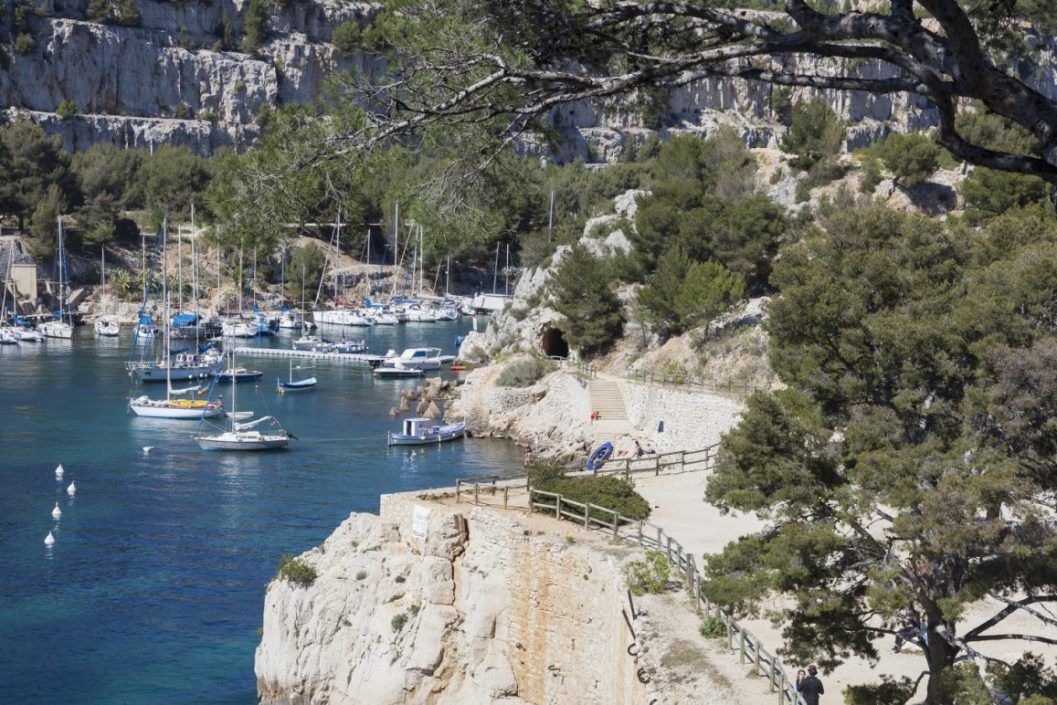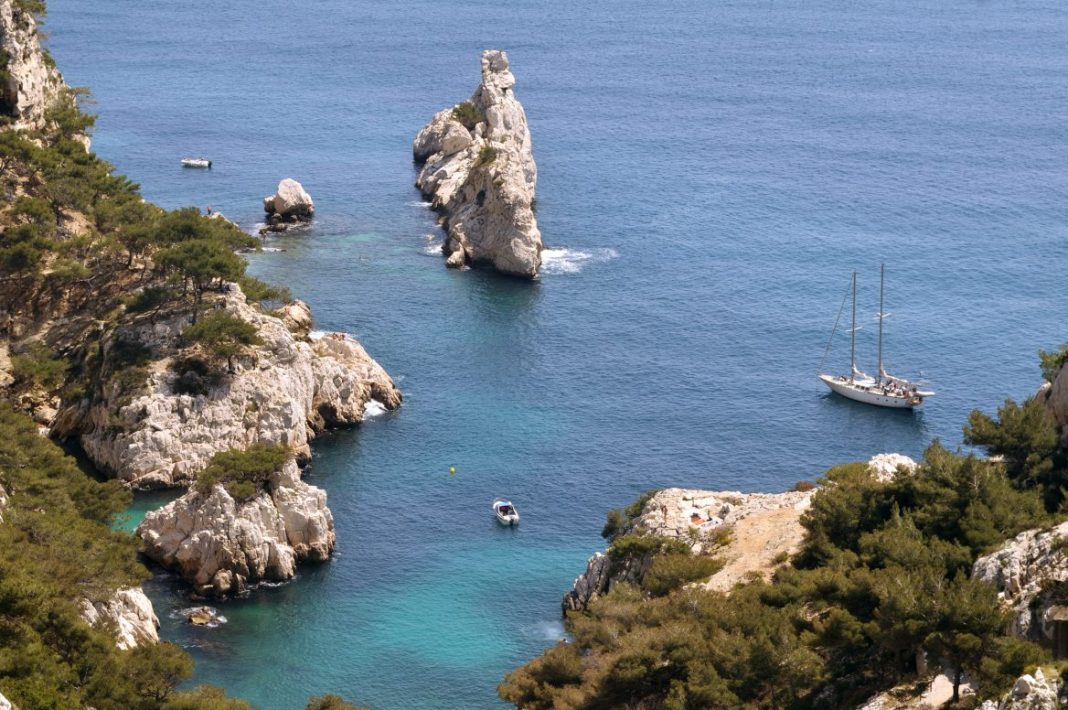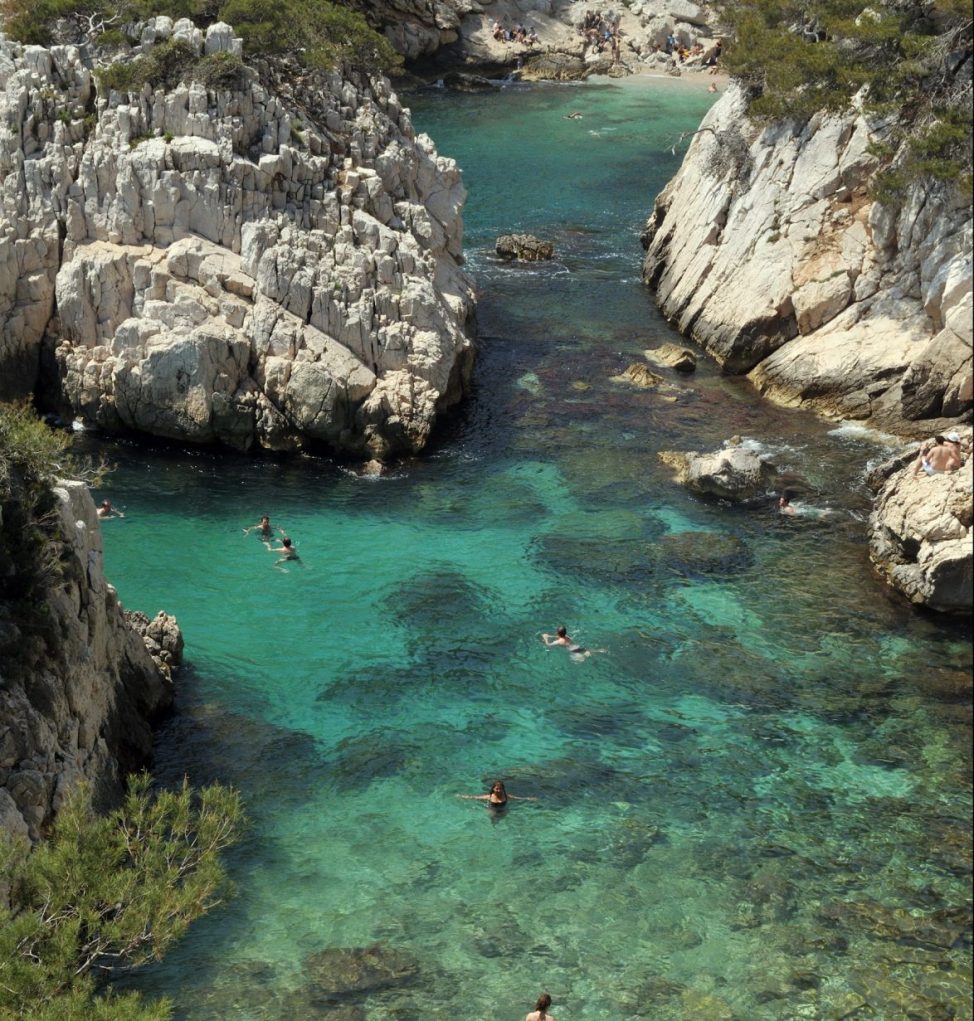Let’s take the plunge the creeks near Marseille ! In the south creeks is translated as “Calanque”. Remember it, nobody will translate this important word.

Feel like creeks and small beaches far from the big sandy expanses? Marseille and its surroundings are full of spots to enjoy the big blue otherwise. Small selection not exhaustive.
The most typical “Calanque”: Marseilleveyre
The path that leads to Marseilleveyre offers a varied landscape, with the Riou archipelago and its islands, its steep rocks, prickly pear trees, and aloe vera on the horizon. After a 45-minute walk along the GR 98 by the sea from Callelongue (terminus of the bus line 20 in Marseille), the sandy and pebbled cove invite you to relax. The more sporty ones rent a kayak or a paddle before taking advantage of the tasty menu of the unavoidable “cabanon du Belge” without water, running electricity, or reservation (spaghetti bolognese 15€).
The best part: to see in the distance the Cap Canaille is overlooking Cassis.
The most prized of the Marseille inhabitants: the creek of Sormiou.
The city is so close and yet so far away. Located in Marseille’s 9th district, Sormiou, which still has about a hundred inhabited huts, has something to seduce tourists and locals alike. To get there, you have to walk for an hour, but the sight is breathtaking: white sand, turquoise waters, rocks suitable for climbing and hiking, an area reserved for bathing supervised in summer. For those lucky enough to reach it by boat, the small sheltered port is perfect for a day-long docking.
The plus: for lunch, the restaurant le Château offers an iodized menu based on fish and local products (starter from 11 €, dishes from 21 €).
Parking available outside the summer season.
The most picturesque: Morgiou
At first glance, the Morgiou cove looks like a small fishing port with a pebble beach, the Nautic Bar, and the cabanons. It can be reached in one hour from Marseille after passing the Baumettes prison and taking a winding road. Morgiou has two beautiful surprises in store for you: the prehistoric cave of Cosquer in the Calanque de la Triperie, now condemned, and the blue cave Cap Sugiton, which can be reached by hiking or by sea.
The most: playing petanque, of course, while sipping a fresh pastis!
The most spectacular: En-Vau
Fans of hiking and climbing swear by the Calanque d’En-Vau, accessible from the Col de la Guardiole or the sea parking lot. They flock here for the chance to climb the white rock faces, between sky and sea. Its geographical location, nestled between two high cliffs, makes it an incredible spot. The translucent water is a delight for the (very numerous) bathers in summertime despite a small pebble beach quickly crowded without forgetting the kayakers, delighted to take a dip for an hour paddling from Cassis (lokayakcassis.com).
The plus: the rocky needle Le doigt de Dieu, which offers a spectacular view above the cove.
The most fragrant: Port-Pin
The deep green of the pine trees contrasts with the turquoise blue of the water. Located between En-Vau and Port-Miou, in the Vaufrèges district, the Port-Pin cove is easily accessible from Cassis in less than 30 minutes. With its sandy and pebble beach, it is ideal for family swimming and discovering the underwater world. Its rocks offer a space particularly suited to picnics in the shade of Aleppo pines and thus preserve its wild side.
The best part: the rocks are sheltered from the Mistral wind.
The most astonishing: Corton
There is no need to plan a vast Foutaa” here. The magnificent pebble cove, located 15 minutes from Cassis, surrounded by a pine forest, is not suitable. Its assets are elsewhere. You have to turn your head to marvel at the surrounding nature: the Cap Canaille, first of all, imposing and majestic and the sea bed, easily accessible. It’s nice to sunbathe in the morning before enjoying an excellent lunchtime formula (34 €) at La brasserie du Corton of La Villa Madie, on the terrace, facing the Mediterranean Sea.
The plus: La Villa Madie has a parking lot.
The most paradisiacal: the Monkey Bay
Far from everything in a lunar and wild atmosphere. At the end of the road, after the Calanque des Goudes, surrounded by a few huts, one feels at the end of the world facing Maïre Island. This rock, which marks the Phocaean city’s entry, can be contemplated during hours, sitting on the rock. The mini beach satisfies the swimmers searching for freshness while the outside temperatures are close to 30°.
The plus: taste the restaurant’s bouillabaisse with a view of the Baie des Anges before falling asleep on one of the deckchairs.
The most cinematographic: Méjean
In Ensuès-la-Redonne, a small town west of Marseille, after l’estaque, the Méjean cove looks like a postcard. It is divided into two parts with, on one side, a fishing port where one nibble in the shade at the Mange-Tout and on the other, the pretty cove of the great Méjean where diving enthusiasts are filled with underwater riches before lazing on one of the rocks.
Advantage of this creek: take one of the many hiking trails, including the famous “Sentier des douaniers” (customs officers’ path), to admire the magnificent viewpoints on the big blue sea.
The most secret: Ervine
Diving in its crystal clear waters is well deserved! The Calanques de l’Erévine is located one hour walk from Niolon and Méjean, at the railway’s bottom. Seeing it from the hiking trail, on the Côte Bleue, we have only one desire: to go down. Once we arrive, after taking a nice slope, a turquoise sea stretches out, and on the right is the island of L’Erévine and a crushing tower of the 20th century and behind us rises the Viaduc de Baume.
Best part: the depths are quickly deep and, therefore, suitable for divers.
The most secret: Les Bouchons
Still, this charming cove remains less frequented on the west side and yet little known to the general public. It is accessed by sea, paddle or kayak. On foot, from the beach of Le Rouet, one enters the residential area of Barqueroute before taking a small staircase that leads to a footpath and the alley of Cap de Nantes. Located in the heart of a protected marine park, the calanque des bouchons is perfect for snorkeling. A few meters away, the Cap Rousselet cove is also a delight for diving and lazing around, delighted to settle down on the terrace of the refreshment bar on the sandy beach.
Best part: just put on your mask, fins, and snorkel to enjoy the underwater show.
The most cinematic: Méjean
In Ensuès-la-Redonne, a small town west of Marseille, after l’estaque, the Méjean cove looks like a postcard. It is divided into two parts with, on one side, a fishing port where one nibble in the shade at the Mange-Tout and on the other, the pretty cove of the great Méjean where diving enthusiasts are filled with underwater riches before lazing on one of the rocks.
The plus: take one of the many hiking trails, including the famous “Sentier des douaniers” (customs officers’ path), to admire the magnificent viewpoints on the big blue sea.
The most secret: Ervine
Diving in its crystal clear waters is well deserved! The Calanque de l’Erévine is located one hour walk from Niolon and Méjean, at the railway’s bottom. Seeing it from the hiking trail, on the Côte Bleue, we have only one desire: to go down. Once we arrive, after taking a nice slope, a turquoise sea stretches out, and on the right is the island of L’Erévine and a crushing tower of the 20th century and behind us rises the Viaduc de Baume.
The best part: the depths are quickly deep and, therefore, suitable for divers.
The most secret: the Corks
Still, this charming cove remains less frequented on the west side and yet little known to the general public. It is accessed by sea, paddle or kayak. On foot, from the beach of Le Rouet, one enters the residential area of Barqueroute before taking a small staircase that leads to a footpath and the alley of Cap de Nantes. Located in the heart of a protected marine park, the calanque des bouchons is perfect for snorkeling. A few meters away, the Cap Rousselet cove is also a delight for diving and lazing around, delighted to settle down on the terrace of the refreshment bar on the sandy beach.
The best part: just put on your mask, fins, and snorkel to enjoy the underwater show.

An island so green
At 420 meters from the mainland, “l’île Verte” (the green island) belongs to the commune of La Ciotat, from where the daily shuttle bus leaves (departure every hour, 12 € per adult). The eastern part is home to three small beaches: the Calanque de la Plageolle, the coast of Saint-Pierre, and the beach of Seynerolle. The Aleppo pine forest brings an extra touch of exoticism to this ideal getaway.

photo credits : OT Bouches du Rhône